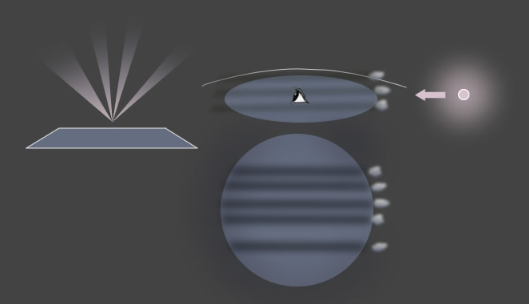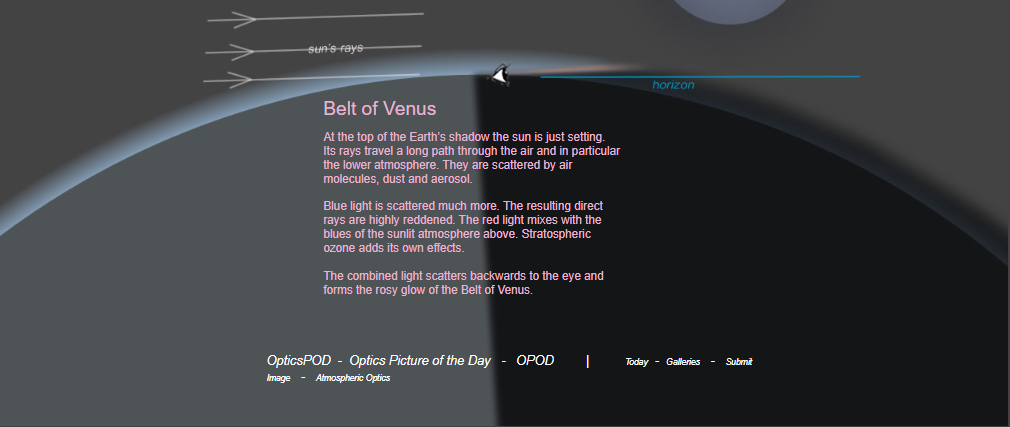Antisolar Rays & Belt of Venus - OPOD
Antisolar Rays & Belt of Venus - A Captivating Atmospheric Phenomenon
Have you ever witnessed the mesmerizing display of antisolar rays and the ethereal Belt of Venus in the sky? These captivating atmospheric optics phenomena can create a truly dramatic scene, as captured by Zhuo-xiao Wang from the summit of Mauna Kea, Hawaii. Let's delve into the enchanting world of antisolar rays and the Belt of Venus to understand the science behind these awe-inspiring spectacles.
Antisolar Rays: Convergence in the Sky
Shadows of clouds on the western horizon seem to defy logic as they appear to converge towards a single point directly opposite the sun. Although these shadows are actually parallel, our eyes perceive them as converging, much like railroad tracks. These converging shadows are known as antisolar rays, or anticrepuscular rays.
During the day, the antisolar point lies below the horizon. However, after sunset, it gradually rises into the sky. As twilight envelops the Earth, we can still witness the mesmerizing display of antisolar rays. These rays pass through the upper atmosphere, which is still illuminated by the fading sunlight, casting a mystical glow.
The Enigmatic Belt of Venus
As the sun sets on the horizon, a remarkable phenomenon known as the Belt of Venus emerges. At the top of the Earth's shadow, the sun's rays traverse a lengthy path through the atmosphere, particularly the lower layers. Along this journey, the sunlight is scattered by air molecules, dust particles, and aerosols present in the atmosphere.
Among the different wavelengths of light, blue light scatters more easily than others. Consequently, the direct rays from the sun become highly reddened. This reddened light then intermingles with the blue hues of the sunlit atmosphere above. Additionally, stratospheric ozone contributes its own effects to this captivating interplay of colors.
The combined effect of these scattering processes results in the formation of the rosy glow known as the Belt of Venus. This atmospheric phenomenon bathes the sky in a warm pink hue, adding an ethereal touch to the surrounding scenery.
The Science Behind the Spectacle
To better understand the science behind antisolar rays and the Belt of Venus, it is essential to consider the intricate interplay of light and atmospheric particles. Here are some key factors that contribute to the formation of these captivating phenomena:
-
Sunset Angle: The angle at which the sun sets plays a crucial role in the appearance of antisolar rays and the Belt of Venus. As the sun descends below the horizon, its rays pass through a larger portion of the Earth's atmosphere, allowing for more scattering and interaction with atmospheric particles.
-
Scattering of Light: The scattering of sunlight by air molecules, dust, and aerosols causes different wavelengths of light to scatter at varying degrees. Blue light, being shorter in wavelength, scatters more easily, while red light is less prone to scattering. This scattering process leads to the reddening of direct sunlight and contributes to the vibrant hues observed in the Belt of Venus.
-
Ozone Influence: Stratospheric ozone, present in the upper layers of the atmosphere, also influences the appearance of the Belt of Venus. Ozone absorbs certain wavelengths of light, contributing to the unique coloration observed during sunset and sunrise. Its presence adds an additional layer of complexity to the atmospheric optics display.
Captivating Scenes from Nature
The enchanting spectacle of antisolar rays and the Belt of Venus can be witnessed across various locations around the world. Whether you find yourself atop a mountain peak or on a serene beach, these atmospheric phenomena never fail to captivate and inspire. Here are a few locations renowned for offering breathtaking views of these natural wonders:
-
Mauna Kea, Hawaii: The summit of Mauna Kea, standing tall in the Pacific paradise of Hawaii, provides an exceptional vantage point to observe the interplay of antisolar rays and the Belt of Venus against a backdrop of stunning natural beauty.
-
Sahara Desert, Africa: The vast expanse of the Sahara Desert offers a canvas for the dramatic display of atmospheric optics phenomena. With its expansive horizons and minimal light pollution, the desert becomes a stage for nature's breathtaking light show.
-
Arctic and Antarctic Regions: The polar regions, known for their pristine beauty and otherworldly landscapes, offer a unique opportunity to witness the dance of light in the sky. In these remote locations, where the sun hovers close to the horizon during certain times of the year, the interplay of colors becomes even more pronounced.
A Reminder of Nature's Splendor
Antisolar rays and the Belt of Venus serve as a beautiful reminder of the intricate wonders that surround us in the natural world. These captivating atmospheric phenomena showcase the harmonious interplay between light, particles, and the Earth's atmosphere. As we gaze upon these awe-inspiring displays, we are reminded of the boundless beauty and complexity of our planet.
So, next time you find yourself marveling at the convergence of shadows or being entranced by the rosy glow on the horizon, take a moment to appreciate the science behind these mesmerizing spectacles. Nature's artistry is on full display, inviting us to embrace the enchantment that lies just beyond our reach.

Antisolar Rays & Belt of Venus ~ Zhuo-xiao Wang captured this dramatic scene from the summit of Mauna Kea, Hawaii. Antisolar (anticrepuscular) rays and shadows stream downwards to the point directly opposite the sun. The sky is suffused by the warm pink glow of the Belt of Venus. Beneath all that is the dark shadow of the earth itself cast through the atmosphere. Image ©Zhuo-xiao Wang, shown with permission

Antisolar Rays
Shadows of clouds on the western horizon cross the sky. They are parallel. But to the eye they appear to converge - like rail-road tracks - to the point directly opposite the sun.
The antisolar point is below the horizon by day. After sunset on the ground it rises into the sky. We may still see antisolar rays because they are then passing through the still sunlit upper atmosphere.

Belt of Venus
At the top of the Earth’s shadow the sun is just setting. Its rays travel a long path through the air and in particular the lower atmosphere. They are scattered by air molecules, dust and aerosol.
Blue light is scattered much more. The resulting direct rays are highly reddened. The red light mixes with the blues of the sunlit atmosphere above. Stratospheric ozone adds its own effects.
The combined light scatters backwards to the eye and forms the rosy glow of the Belt of Venus.
Note: this article has been automatically converted from the old site and may not appear as intended. You can find the original article here.
Reference Atmospheric Optics
If you use any of the definitions, information, or data presented on Atmospheric Optics, please copy the link or reference below to properly credit us as the reference source. Thank you!
-
<a href="https://atoptics.co.uk/blog/antisolar-rays-belt-of-venus-opod/">Antisolar Rays & Belt of Venus - OPOD</a>
-
"Antisolar Rays & Belt of Venus - OPOD". Atmospheric Optics. Accessed on November 26, 2024. https://atoptics.co.uk/blog/antisolar-rays-belt-of-venus-opod/.
-
"Antisolar Rays & Belt of Venus - OPOD". Atmospheric Optics, https://atoptics.co.uk/blog/antisolar-rays-belt-of-venus-opod/. Accessed 26 November, 2024
-
Antisolar Rays & Belt of Venus - OPOD. Atmospheric Optics. Retrieved from https://atoptics.co.uk/blog/antisolar-rays-belt-of-venus-opod/.